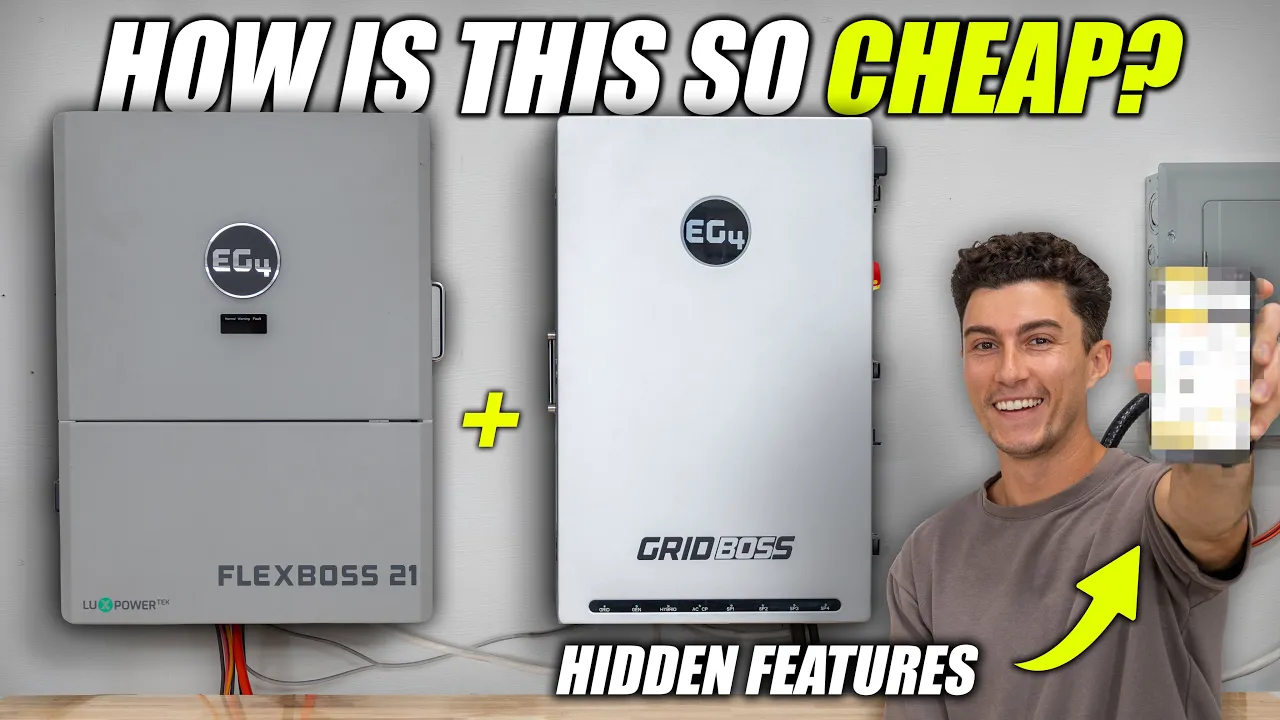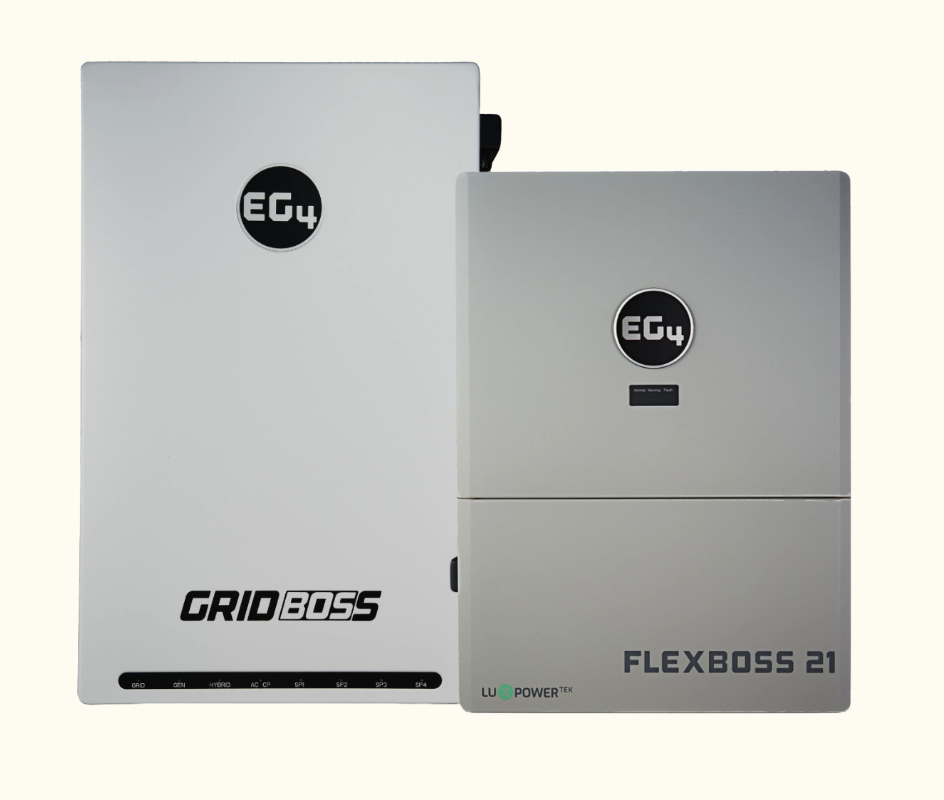

EG4’s new GridBOSS and FlexBOSS pair feel like the kind of practical innovation the solar industry actually needed. They’re not the flashiest pieces of equipment, but we think they can be incredibly useful for a lot of solar and backup power systems.
If you’re planning a hybrid solar power system install and need simplified code-compliance, as well as intelligent load management, this duo deserves a hard look. We’ve reviewed and we now regularly recommend the EG4 GridBOSS MID, EG4 FlexBOSS18, and the EG4 FlexBOSS21, but we’ve never really explained why these units can make such an effective pairing. That’s what we’re going to do with this guide.
We’ll explain what each unit does, how they work together, as well as real-world features they enable, like load-shedding, gas generator integration, and smart port management. We’ll also highlight a few clever hacks we discovered when we were reviewing them.
Let’s find out why you should be investing in the EG4 GridBOSS and EG4 FlexBOSS for your solar power system.
At its core, both versions of the FlexBOSS are inverters, but neither are your typical hybrid inverter for solar. While they are both split phase hybrid inverters, they were designed to work with the GridBOSS MID in order to reduce installation expenses and simplify code compliance.
When designing the FlexBOSS18 and FlexBOSS21 Inverters, EG4 intentionally omitted a built-in 200A bypass (the heavy-duty transfer hardware found in some hybrid inverters). The intention behind this decision was to reduce installation costs and complexity for off-grid users who don’t need a service-entrance bypass inside every inverter.
Basically, if you have an off-grid system, you're only paying for what you need. For those running hybrid systems, the FlexBOSS units act as the inverter, while the GridBOSS enables you to connect your inverter to the grid. The best part is the GridBOSS MID is cheaper to purchase and install than the components you’d need to connect a standard inverter to the grid. Plus, the combination of a FlexBOSS and GridBOSS looks really clean, and this pairing opens up a bunch of useful features we’ll discuss below.
The FlexBOSS units weren’t just designed to save those with off-grid systems money; they’re also just really impressive solar inverters in terms of performance. For starters, ours was able to start a 5-ton HVAC system straight out of the box, with no need for a soft starter.
They also have really high solar inputs, making them ideal for those using solar for off-grid purposes, home backup, tiny homes, and pretty much any other situation where you’d want to use solar power to run home appliances.
They are also very intuitive, as well as really easy to monitor and control. After installing the FlexBOSS and GridBOSS, you can control everything about your solar power system using advanced settings, which can be done through a mobile app or with your computer.
You get the high performance of a high-capacity hybrid inverter without paying for a 200A bypass you may not need. This is particularly beneficial for off-grid and battery-first solar power setups.
What about those who do need grid connectivity? You can pair either of the FlexBOSS Inverters with the GridBOSS MID, which simplifies code compliance, enables smart load management, and just looks way better than a messy system with multiple manual bypasses.
If you’re still feeling confused, or you just want to read more about either unit, we’ve reviewed both the FlexBOSS18 and the FlexBOSS21 in full separately:
Read our EG4 FlexBOSS18 Review and our EG4 FlexBOSS21 Review
According to EG4, the GridBOSS MID is a Micro-grid Interconnection Device (where the MID comes from), as well as a service-entrance controller.
Sounds like a confusing word salad, but it’s basically just a tidy, code-friendly box that converts a FlexBOSS Inverter setup into a true hybrid system. Instead of hanging a separate manual bypass, transfer switch, and all of the additional wiring to connect them together on your wall, the GridBOSS bundles that functionality into one device.
If you’re thinking it sounds like an unnecessary cash grab from EG4, it’s actually the opposite. EG4 designed each FlexBOSS All-in-One Hybrid Inverter to help save off-grid users money. With the FlexBOSS, those that don’t need grid connectivity don’t need to pay for it.
Now you’re probably thinking: aren't those with hybrid and grid-tied systems just being forced to pay extra for the GridBOSS to save off-grid users money? Turns out, they also save money!
Normally, connecting an inverter to the grid means installing a separate manual bypass, then getting that setup inspected in order to meet code requirements.
EG4 averaged out the cost of buying and installing these additional components at over $2,000 per inverter. They then priced their EG4 GridBOSS MID at around $1,799. They even claim that this more cost-effective design can lower equipment and labor costs by around $7,500 on a typical installation!
So, not only is the GridBOSS MID cheaper than manually installing a 200A bypass and transfer switch, it makes it way easier to pass electrical inspections, looks cleaner, and is way easier to install.
Basically, the FlexBOSS + GridBOSS pairing is a winning combination for off-grid, hybrid, and grid-tied solar power systems. You can read more about the GridBOSS in our dedicated review: EG4 GridBOSS MID First Look & Review
Beyond saving you money on components and installation costs, pairing one or more FlexBOSS units with the GridBOSS unlocks the following features:
A single GridBOSS MID can accept up to three FlexBOSS inverters (so you don’t need to buy extra bypass hardware per inverter). Whether you just want the option to expand your system in the future, or you're starting out with multiple inverters, you save even more money, and you have to deal with fewer installation headaches and code compliance measures.
Not only does the GridBOSS simplify system integration and save you money, you unlock advanced load management features. With five programmable ports, you get precise energy distribution for your entire system.
Whether you want to prioritize certain loads, or have less important loads switch off when your batteries run low, or when your solar panels are less productive, you can do so with the GridBOSS. You can even use these smart ports to turn whole subpanels on and off automatically.
Let’s say you have an EV charger that you want to run through your solar power system. You could hook it up to one of the GridBOSS MID’s programmable smart ports. This would allow you to set it up so it only charges your vehicle at certain times, say when you have enough solar power stored in your batteries, or with grid power overnight while the utility rates are low. From getting the most out of your solar power and being able to peak shave to prioritizing critical loads during blackouts, these smart ports help you automize your entire system.
You also get straightforward inputs for solar, a gas generator, and grid power. With the automation of the smart ports and remote monitoring and settings control you get with the app and computer connectivity; you can easily streamline your entire solar and backup power system.
Rather than having a mess of wires and components, you get a clean physical layout and straightforward wiring path that offers unmatched control and flexibility.

Put simply: FlexBOSS = inverter and the GridBOSS = the brains + bypass.
You can wire up to three FlexBOSS inverters to the GridBOSS MID, then the GridBOSS handles code-compliant transfer switching, load shedding, generator logic, and smart port settings.
Once connected, you can:
We know, this all sounds pretty complicated, but the main takeaway is there’s a huge amount of customization and automation you can do with this system.
This is really the feature that made us actually say “wow” during our testing.
Basically, each smart port can be configured to shed loads based on battery state of charge (SoC), time windows, or a huge variety of other custom rules.
When we were testing this system, we used Smart Port 1 and Smart Port 2 with simple thresholds: turn off our EV charger at 87% SoC, and turn off our garage heater at 85% SoC.
When our battery bank fell below those thresholds, the GridBOSS turned the loads off, and when the battery recovered above the re-enable limit, the loads came back on automatically.
Again, this sounds like it isn’t that big of a deal, but any time you can automate power usage, the easier it is to just sit back and let your system save you money and simplify your life. For grid power outages that occur when you're not home, this can also be incredibly beneficial. If you're away and lose power, you don't have to worry about your fridge and other critical loads shutting off.
As mentioned, you could also assign whole subpanels to a smart port. That means you could shed an entire wing of your home during low battery periods, or give priority to your most critical loads during outages.
Let’s say you have your system set up this way, then imagine you encounter a major grid failure. You could have your main living space running as usual, while less important sections of the home lose power, so you stretch your stored battery power longer.
This granular, automated control is how you squeeze more useful energy out of a smaller battery + solar + gas generator combo. It’s precisely why a GridBOSS + FlexBOSS combination makes hybrid power systems smarter, not just bigger and less expensive.
EG4 doesn’t even advertise this, but it’s something we discovered during our testing: the GridBOSS can allow you to get more out of a smaller gas generator.
If you don’t already own a gas generator, but you want one as power security for grid failures and days when your solar power system isn’t pulling enough power, you can get away with a less expensive genset.
This is because you can tie a generator with dry-contacts into the GridBOSS and have it start automatically when needed. The system can then supplement specific smart ports with gas generator power during emergencies. It’s almost like the GridBOSS turns your cheap generator into something like the EcoFlow Smart Gas Generator 4000, which is a $1,700 piece of equipment!
Again, this flexibility and smart power management means you can often get away with a smaller generator than a traditional whole-house genset. The generator only needs to cover typical running loads and leaves the rest to the batteries. Smarter use of power also means less wasted fuel.
Beyond getting more juice out of a smaller gas generator, another pair of surprising features we came up with was using this pairing to get extra use out of an existing power station, and upgrading an older home with a more powerful system.
While they might not be relevant for everyone, here’s how these bonus tips would shake down:
The EG4 FlexBOSS21 + GridBOSS combo is one of the most pragmatic, installer-friendly, and feature-complete hybrid building blocks we’ve seen in 2025.
While we weren’t even sure what it was at first, we’ve since used this combination heavily and discovered it reduced installation complexity, while also providing professional-grade bypass hardware without the messy wall-mounted switches.
Even if it didn’t make installation easier than a traditional hybrid inverter setup, it also opens up real, actionable control over how power flows in your home via smart ports and a gas generator input.
Put bluntly, if you’re building a hybrid system, this combination is pretty much impossible to beat when it comes to value, useful features, and future-proofing your solar or backup power setup.
